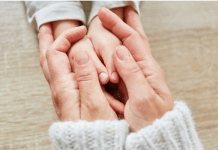What is Endometriosis?
It is a painful and chronic disease in which tissue that normally lines the inside of your uterus — the endometrium — grows outside your uterus. With endometriosis, displaced endometrial tissue continues to act as it normally would — it thickens, breaks down and bleeds with each menstrual cycle. Because this displaced tissue has no way to exit your body, it becomes trapped. {Source: Mayo Clinic}
March is Endometriosis Awareness Month, and today marks the annual Worldwide Endometriosis March. #EndoMarch2018
My Personal Struggle with Endometriosis
“I peeled your left ovary like an orange,” the surgeon said as he held up his fist to demonstrate. “I was able to save it, so it should produce eggs but at a diminished capacity.”
Wait. What? I tried to focus while coming out of the fog of anesthesia.
Even though he removed most of the endometriosis from my organs, he was treating me like every other doctor along the way. Like my feelings didn’t matter. Like just another patient who wouldn’t understand so why bother explaining. Like a number in a long line of nobodies.

Well, it’s my turn now, and I have a few numbers of my own.
17 Years Old
My younger brother helped me get up the stairs to my bedroom. We were in high school, and my parents had already left for work that day. I was supposed to drive us there, but that wasn’t possible.
I folded at the waist, doubled over in pain. I could hardly breathe, and my insides twisted like a towel being wrung out in the kitchen sink. Nausea crept up and caught in my throat. My lower back throbbed with a steady, marching beat.
My brother thought I was dying. It came on that suddenly. One minute I was eating breakfast and packing my book bag, and the next one, I was literally gritting my teeth, trying to get to my bed before curling up in a ball. He called my mom in a panic. But I knew it was just my period.
Nothing four ibuprofen every couple of hours and an extra large heating pad wouldn’t solve.
10 Pounds
“My cramps are really bad,” I said. She didn’t seem alarmed and wanted to know if I could function. Most of the time I could get through my day with one of those stick on heat wraps and a bunch of pain relievers. Apparently, that’s functioning. So she told me:
“You need to put some meat on your bones. 10 pounds at least. It will get better then.”
8 Days
I planned my life around my period. If friends wanted to go dancing on one of those days, I made up an excuse. Or I told the truth. Either way, I didn’t go. When I worked retail, I requested off the first day–the worst day–of my cycle. Being on my feet for eight hours wasn’t an option because my pain increased with movement and exercise.
Later, when I became a teacher, I planned my lessons around my anticipated pain level–group work let me stay seated and roll in my desk chair to each team as needed.

It consumed a lot of my thoughts before it arrived and literally depleted my energy for eight days every, single month.
5 Doctors
I visited 5 different gynecologists until one referred me to a fertility specialist, who ultimately gave me the diagnosis of endometriosis. They had a lot of ideas though:
“You need water pills,” he told me. “You are retaining water, which is putting pressure on your abdomen. That’s why your cramps are so severe.”
“It’s the joy of being a woman,” she explained while I wore a paper gown and stared at the floor.
“Have you tried exercise? Or eliminating dairy?” another one asked after I told her that I knew this kind of pain wasn’t normal.
But as soon as I said that I had been trying to have a baby for more than a year at the age of 29, they were very interested in figuring out my problems instead of brushing them aside. Only when I couldn’t fulfill that societal duty did anyone actually care about my physical pain. A few months later, I had that surgery to remove the endometriosis.
(If you’re planning to see the doctor about your symptoms, I recommend visiting Speak Endo and Endometriosis Foundation of America for helpful tips!)
4 Stages
I had the most severe–stage 4–which involved deep implants of extra tissue on my ovaries, Fallopian tubes, and several other organs in my abdominal cavity. Even after it was removed, scar tissue remained, and the damage was permanent.
Endometriosis is never really gone. It comes back–a little at a time, month after month. Many women have multiple surgeries to keep it under control. There is not a cure or even a standardized treatment plan.

1 in 10 Women
Unfortunately, my endometriosis story is not unique. One in 10 women in the U.S. are affected, and 176 million women worldwide suffer from it. In recent years, many celebrities–like Lena Dunham, Tia Mowery, and Juilanne Hough– have come forward with their own endo experiences to raise awareness and to help reduce the stigma.
I’m speaking up now because I know better.
Be persistent.
Demand answers.
I’m the one in 10. As it turns out, that’s the number that matters.















